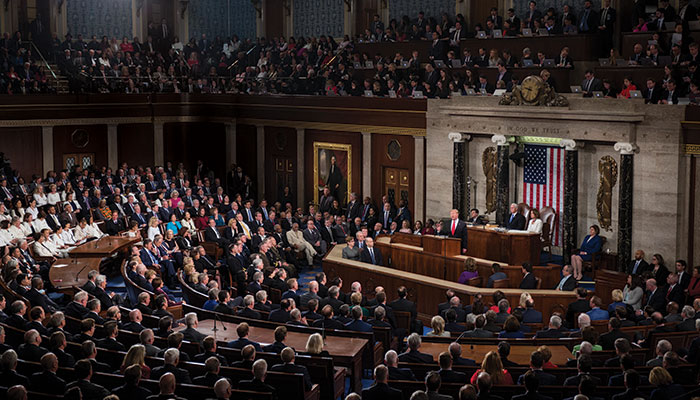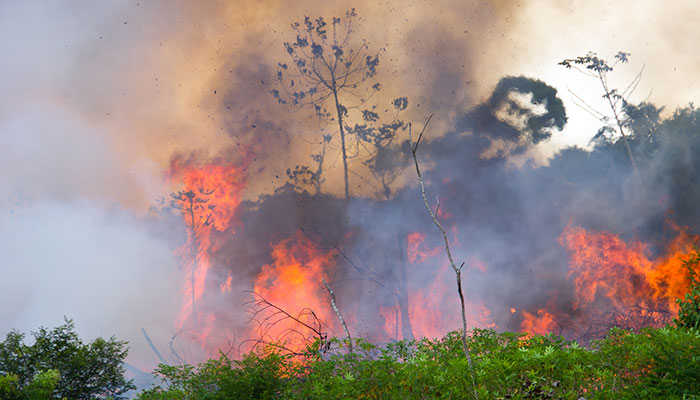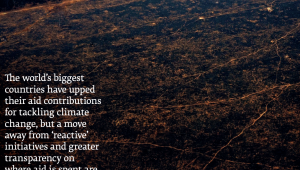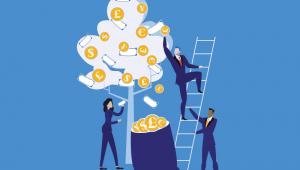Fires that swept through the Amazon rainforest this summer catapulted environmental and climate change issues into the public consciousness and up the political agenda.
French president Emmanuel Macron tweeted “our house is burning” and called for the fires to be discussed at that weekend’s meeting of the G7.
The G7 responded by offering Brazil £18m to fight the fires, addressing concerns that they could hasten global warming – releasing carbon dioxide into the environment and reducing the rainforest’s ability to pull carbon out of the atmosphere.
The £18m of aid was rejected by Brazilian president Jair Bolsonaro amid an ongoing feud with Macron.
However, it was also derided as “chump change” by Greenpeace UK’s head of forests Richard George, who cited additional rampaging wildfires as not just contributing to global warming but as evidence of the rapid advance of climate change.
Wildfires also tore through territory within and close to the Arctic Circle this summer, mostly in Russia but also in Alaska and Greenland. Greenpeace Russia said on 29 July that 3.3m hectares of forest – an area greater than the size of Belgium – had burned.
So how are countries deploying aid to tackle the threat of climate change – and how do they ensure their initiatives protect the communities most at risk from it?
The World Bank estimates that 100 million people will be pushed into poverty by climate change if the world does not act immediately.
Many developed countries are now responding by increasing funding to tackle the issue.
Last year, Sweden – the world’s biggest spender on international development as a proportion of gross national income (1.4%) – enshrined climate change into its strategy for the coming years. Millions will be spent specifically on projects to fight climate change or build resilience against its effects.
The UK – the world’s third biggest spender in absolute terms on aid, behind China and the US – recently doubled its contribution to the Green Climate Fund, to £1.44bn over the next four years.
The Department for International Development says UK aid efforts have reduced greenhouse gas emissions by 16 million tonnes, the equivalent of taking three million cars off the road for a year.
International development secretary Alok Sharma says he is “proud” of the work, but acknowledges “there is absolutely no room for complacency”.
Furthermore, in an agreement signed in Copenhagen in 2009, developed countries committed to spending $100bn a year on fighting climate change, a commitment that was reaffirmed in the Paris Agreement, signed in 2016.
OECD research shows those countries spent $71bn in 2017, and conservatively suggests they “remain on track” to meeting the target.
'Local people really understand the problem best, but the analysis is done by ‘experts’ sitting far away from where the problem is. The way that decisions are made just doesn’t work at all for climate change. It needs to be much more ‘bottom-up’'
Clare Shakya, International Institute for Environment and Development
The picture in the US is a little less clear. President Donald Trump’s administration said in 2018 that it was cutting the country’s contribution to the Global Environment Facility by half, which would have left it around $300m short of its previous funding levels.
Congress eventually allocated more than the president recommended, and budgets from the house and senate indicate that funding may not drop at all. But uncertainty remains over how committed the US – the world’s biggest spender on aid – is to addressing the threat of global warming.
The US was one of just three Annex I countries – developed nations that were members of the OECD in 1992 – that did not submit its biennial climate report to the UN, along with Ukraine and Belarus. This report would have made it clear exactly how much of its aid spending went on climate change.
Developed countries certainly appear to be taking climate change more seriously. However, complete transparency on how much is being provided by donor countries and how money is being spent appears to be lacking.
Clare Shakya, director of the International Institute for Environment and Development’s climate change group, says IIED research shows that just 7% of climate finance is transparent enough to track exactly how it is being used – leading to distrust ‘on the ground’ in the places where aid is being deployed.
“There is some resistance to being clear about what’s being done,” Shakya says.
“Some donors – at least in the past – were counting programmes that increased efficiency in coal power as ‘climate finance’. Clearly, anything to do with coal power shouldn’t be considered that way at all.”
One problem, she says, is that input sector codes, which are used to categorise aid spending, limit transparency.
Projects are often listed with codes that are too vague, such as ‘education facilities and training’, says Shakya, adding that these labels tell people little about exactly where the money is going. Furthermore, she says that donors often give projects names that are later changed by agencies, NGOs or firms – leading to what she describes as a “huge obfuscation”.
Despite some good examples, such as DfID’s ‘Devtracker’, which offers detailed information on specific projects, climate financing has a long way to go before it can be considered truly transparent, Shakya adds.
A lack of transparency also hinders the ability to ensure initiatives are helping those most in need, according to Shakya.
Many of the people most threatened by climate change already live in poorer communities – indigenous people and communities with coastal or agricultural livelihoods. Smallhold farmers in developing countries, for example, feel the effects of climate change – such as droughts – at a rate far outweighing other areas.
'While you can talk about resilience in a positive way, it sort of clashes with the goal of transforming society. Many adaptation projects make people more vulnerable – not less.'
Dr Lisa Schipper, Environmental Change Institute, Universit of Oxford
“Local people really understand the problem best, but the analysis is done by ‘experts’ sitting far away from where the problem is,” Shakya says. “These experts can only generalise a good response, but local people can ensure responses are appropriate to their specific context.
“Business as usual isn’t working,” she says. “The way that decisions are made just doesn’t work at all for climate change. It needs to be much more ‘bottom-up’.”
Dr Lisa Schipper, environmental and social science research fellow at the University of Oxford’s Environmental Change Institute, says another major issue for debate when it comes to climate change funding is how money should be split between preventative initiatives versus ones that deal with outcomes.
“Part of the problem is that there are very different interpretations of what we are trying to achieve,” she says, pointing to discussion over how much development money should be spent on climate change mitigation, such as efforts to reduce emissions, versus adaptation – increasing the ability of communities to deal with the impacts of global warming.
The OECD found that 66% of climate finance in 2017 went on mitigation projects, 21% on adaptation and the remainder on ‘cross-cutting’ schemes that addressed both.
Schipper says adaptation is a “massive concept”, and “while you can talk about resilience in a positive way, it sort of clashes with the goal of transforming society”.
Solving immediate threats, she says, “might not be the best way to achieve long-term change”.
web_p23_gettyimages-1094228502.jpg

Uncertainty remains over how committed the US - the world’s biggest spender on aid - is to address the threat of global warming
What’s more, she adds, many adaptation projects, “rather than fixing problems in communities, make people more vulnerable – not less.”
She cites the example of Ethiopia, where donors often talk of huge untapped water resources. Irrigation projects have allowed smallhold farmers to grow new crops, but when systems fail because of drought or technical problems, the farmers are left completely unable to adapt because they now rely on growing crops that depend on irrigation.
This “maladaptation”, Schipper says, is the result of donors and agencies not thinking about alternative solutions from the outset: “I find it quite shocking how little the context around these projects seems to matter.”
To fix this, Schipper says aid donors and agencies should work more closely with new communities, looking for alternatives to the traditional approaches. By focusing resources on the same, familiar places, with familiar people and the same organisations, she says, large parts of the global population are at risk of being missed.
Kasia Paprocki, assistant professor in environment at the London School of Economics, cites the example of aid in Bangladesh being used to reshape the economy. Justified by climate change being presented as an existential threat to villages, aid programmes fund the migration of people from rural communities into cities to work in factories.
This adaptation, which Paprocki argues is better thought of as “agrarian dispossession”, is lauded as an opportunity for development and growth.
Last month, the UN released a report into sustainable development, which criticised the prevailing economic model of chasing growth by increasing the consumption of material goods. This, it said, was “no longer a viable option at the global level”.
International development, which in the past has sought to increase prosperity according to the prevailing economic model, has improved countless lives. But, the report says, it has also contributed to bringing the world “close to tipping points with the global climate system and biodiversity loss”. So a change of course seems necessary, not only in how we administer, allocate and report aid but in how we think about development itself.
Donors and institutions seem committed, but they need to pay closer attention to the effects their projects are having, and relinquish some more control on the ground.
Climate change is an existential threat, especially to the planet’s marginal communities, and if they are to survive the coming crisis they will need to be allowed to play a much more prominent role in organising and distributing the means by which their benefactors seek to help them.














